ALLIGATOR
BEHAVIOR page 4c: FEEDING page 3 page 1 2 4 5 6 7 8 9 10 11
This
page was born 07/05/2008. Rickubis designed it. (such as
it
is.) Last update: 07/14/2015
Images
and contents on this page copyright ©2001-2015
Richard M. Dashnau
Most
people have seen programs on television showing crocodiles
attacking large
animals like deer and cattle. While this is amazing, and
sometimes horrifying,
those creatures
are not alligators. The function of a crocodile's
dentition is somewhat different than an alligator's. Alligators
favor prey
items that will fit inside their head. That is, if they
can
swallow it
whole, then they will normally attack it. While I've heard
witnesses tell
of alligators taking deer in the park, the prey was very small
fawns. Alligators
have also been
seen with large nutria. But, most of the time, they will
eat things like small fish, frogs, and crayfish. Snakes and
turtles are
also pursued, with alligators seeming to be especially
well-adapted for
eating turtles. A recent study done in Texas examined the
stomach contents
of about 50 alligators (which were unharmed). Research showed
that only
one of
these alligators had eaten a bird (which couldn't be identified,
it might have already been carrion when taken), and the rest had
stomach
full of small fish and shellfish. I've seen
11-foot alligators going
after prey that was no larger than their largest teeth (very
small frogs
and fish).
December
04, 2005-- I hadn't been at the
park
long before I saw the alligator in the image below.
-------------------------------------------------------------------------------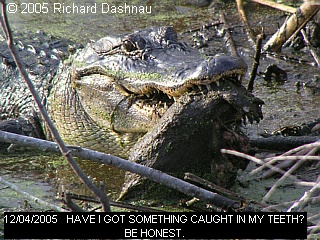
It had
a small mammal in its jaws. I was a little concerned the
dead animal
might be an otter so I watched and waited to see if I could get
some pictures
while the alligator manipulated it. After a
long time, the alligator shifted
its position...moving a little further up onto the bank. Some time
later,
it moved up a little further. My patience was finally rewarded
when the
alligator began crushing
and moving the prey. The three images (toss 3,
4, 5) are photos I shot in a short burst. The fifth image is a
frame from
a video clip of the alligator chewing the prey, which is a large
rodent.
The
large orange incisors are visible at the head. The dead rodent is
probably
a nutria. I've cut a segment out of this clip showing two "chews"
at the
alligator tosses, crushes, then tosses and
crushes the nutria. This short
segment is also shown in a frame-by-frame slow-motion sequence in
which
you can see how the alligators jaws catch and reposition the prey.
However
at the end
of the full clip, another alligator makes an appearance from
behind. This really made things a bit more interesting, and I show
a frame
from the clip in which the new alligator can be seen. (see
THIS COULD BE
TROUBLE, below)
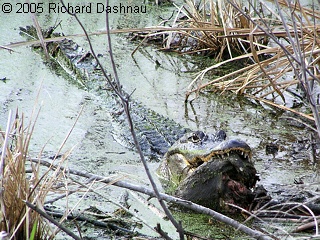 -
-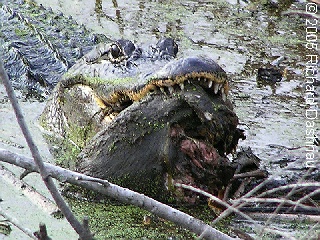 -
-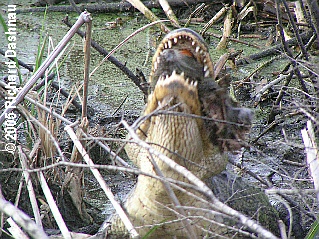 --
--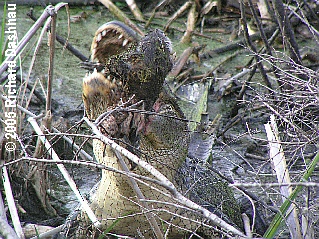
RANCID
BREAKFAST
BREAKFAST
CLOSEUP
TOSSING,
PICTURE
1
TOSSING, PICTURE 2
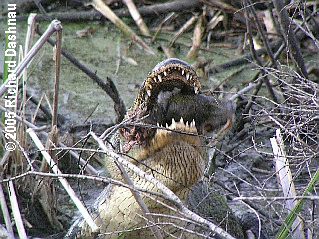 -
-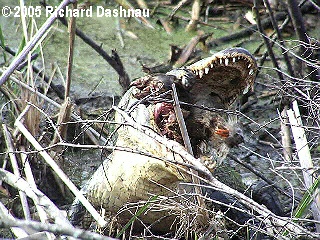 --
--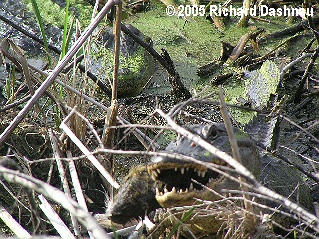 --
--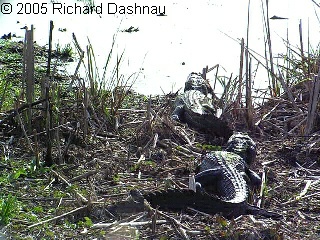
TOSSING, PICTURE
3
SEE?
FOOD.
THIS COULD BE
TROUBLE
THE WALKING CHASE
FULL CHEWING
CLIP 1592kb
WALKING CHASE
CLIP 1811kb
2CHEWS
ONLY CLIP
280kb
2
CHEWS SLOW
MOTION CLIP 1546kb
It's
important to note that there was little sound. The chewing
alligator had
moved entirely onto land. In fact, I had thought it was going to
cross
the trail, but was stopped by the tangled branches of
an old fallen tree.
As the alligator with the mouthful paused (as shown in THIS COULD
BE TROUBLE,
above), the "new" alligator moved forward, as if it intended to
walk over
the chewing alligator.
This movement wasn't hurried, and wasn't accompanied
by any sound. The alligator moved forward, and then "my" alligator
started
moving. I was taken by surprise. These alligators were both
about 8 feet
long, and here they were walking towards me! Although there was no
sound,
and they weren't running, there was a sort of intensity to their
movements
nonetheless. I moved out of the
way ( at least I hoped it would
be out of the way) and tried to film what happened. The next clip
shows
them as they walked by about 8 feet from me and then re-entered
the water.
The image above
is a frame from this clip as they walked away from me (see
THE WALKING CHASE) above. I had been shooting through my
tele-adaptor,
and had to zoom out to catch the alligators as they walked
by. I said
they were close! Any, this explaines the circular vignetting that
you will
see on part of the clip. I just couldn't get over the menace
conveyed
as they walked implacably by. Once the
alligators were in the water, things
became even more interesting.
-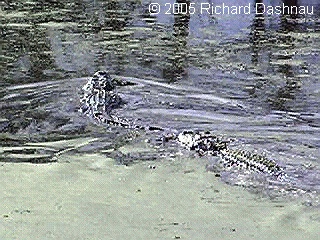 -
-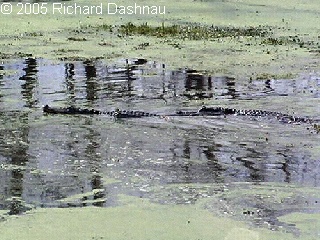 - -
- -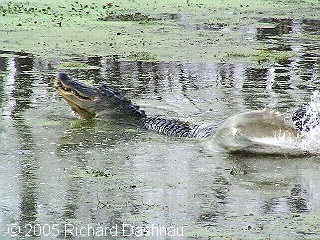
CHASE IN THE
WATER
CHASE
CONTINUES
I'VE
HAD ENOUGH
FIRST
SPEED
TURN CLIP 1111kb STRAIGHT
CHASE
CLIP 618kb SPLASH
AND
DIVE CLIP 3031kb
SPLASH AND
DIVE SLOW
MOTION CLIP 1165kb
The
next picture (CHASE IN THE WATER, above) is a frame from a video
clip showing
the first evasion attempt. The pursued alligator swims straight,
then turns
and accelerates (the tail splashes
the water) 90 degrees to the right.
The pursuer pauses briefly, then accelerates to catch up. The
pursuer turned
left, and was followed closely behind by the pursuer. This is
shown in
the straight
chase clip, a frame of which is shown above (see CHASE CONTINUES).
The pursuer seemed to be trying to crawl on top of the alligator
is was
chasing. It didn't try to grab with its mouth, but just
tried to overtake
the alligator. Both alligators paused briefly, as they do after
strenuous
activity. While they rested, more alligators appeared on the
scene. One
of these, although smaller, seemed
rather brazen. It swam up to the "pursuer"
alligator, moving towards its head as if it knew that someone
had
something good to eat in its mouth. The pursuing alligator turned
away
from this upstart
and towards the "nutria alligator" it had chased before.
Nutria-gator had evidently had enough, and with a quick burst of
speed
that lifted it partly out of the water, it dove. This is shown in
the
"splash
and dive" clip and the image above "I'VE HAD ENOUGH!". I have
another clip
linked above showing the dive in slow motion. In that clip you can
see
that the pursuer had its mouth open
slightly as Nutria-gator dove.
-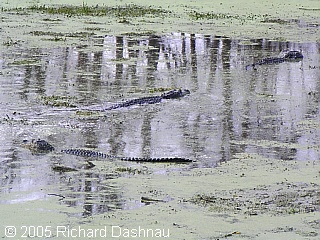 ----
----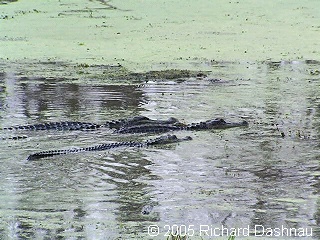 --------
--------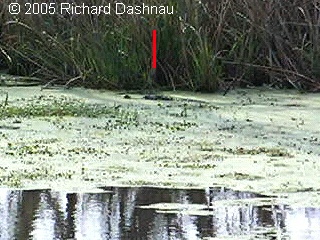 ---
---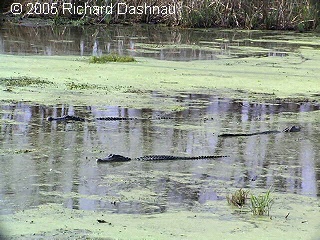
WHERE DID HE
GO?
A
GANG OF
GATORS
PRETTY CRAFTY ALLIGATOR
WE'VE
LOST IT....
GANG SWIMMING
CLIP 1673kbSNEAKY
SWIMMING
CLIP 1111kb CONFUSED
POSSE
CLIP 759kb
After
the dive and turbulance, the other alligators milled around in
confusion.
There were now about 4 other alligators in the area. The image
above "see
WHERE DID HE GO?", shows the
alligators looking in different directions,
and apparently trying to discern where the nutria-gator has gone.
Then
they seemed to swim in formation as seen in the image above (see
GANG OF
GATORS) which is a frame from the "gang clip" linked above. In the
clip
you can see that as they are swimming, one of them (a larger one
and possibly
the original pursuer) breaks off and turns
back towards the left. Through
all this, I was amazed by many things. Through all this
interaction, I
didn't observe even one tail-arch, or any other signal I
have come
to recognise as an alligator
challenge or answer. Then there was
this swimming in formation. Also, why did they all swim in
that direction?
What did they sense? Finally, the large on broke formation (if it
was a
formation)
and swam back towards where the nutria had disappeared. WHY
did it do that?
Meanwhile,
Nutria-gator had surfaced, and was swimming very quietly near the
island,
as shown in the "sneaky swimming" clip and the image above. (see
PRETTY
CRAFTY GATOR, above.
The red vertical line is right aove the alligator.)
Although at this point, I couldn't be sure this was Nutria-gator,
later
events bore out my assumption. Finally, the alligator "gang"
stopped, and
seemed to be watching in all directions. The last image (see WE'VE
LOST
IT, above) and the clip "confused posse" shows the foiled
pursuers.
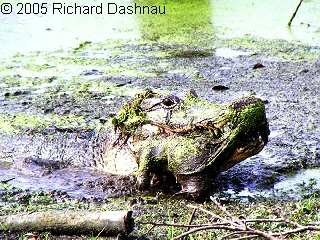 -
- 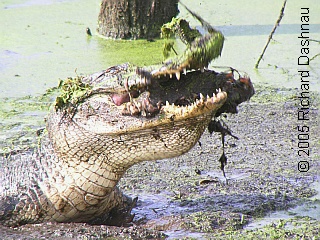 -
-
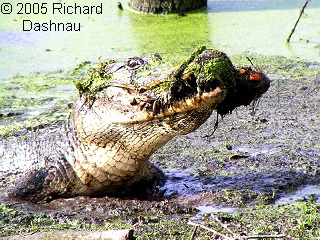 -
-
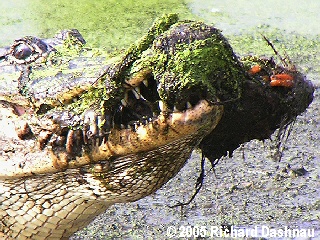
COMING
UP ON
SHORE
FINAL TOSS
01
AND
GRAB
GRAB CLOSEUP
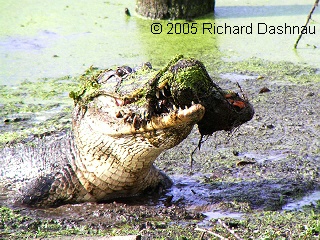 -
- 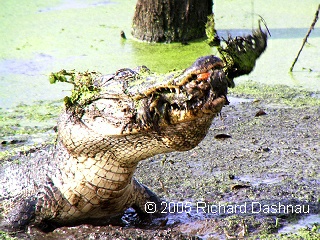 -
-
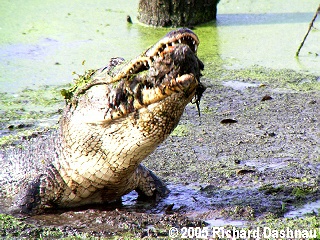 -
-
READY FOR
TOSS
FINAL TOSS
O2
FINAL
GRAB
-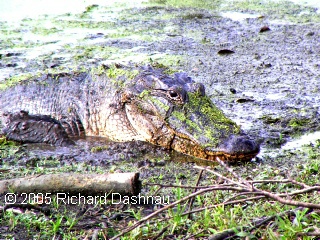 -
-
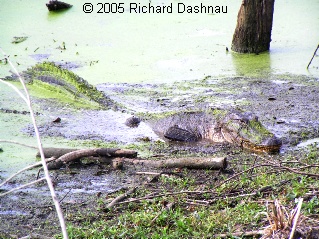
I CAN'T
BELIEVE
I ATE IT
GOT
TO GET IT DOWN!
But,
that still wasn't the end, although the drama had passed.
Nutria-gator
came back to my side of 40-Acre Lake, and ended up about
25 yards
down from where the alligator posse still
waited. It came close to the
bank, and rested. It lifted its head a few times, but didn't chew.
Evidently
if still felt threatened because it moved about 3 more "gator
lengths"
(about 24 feet)
further down the shoreline and further away from the other
large alligators. Then, it moved partly up on the bank. Finally,
with just
a few quick jaw movements, the nutria vanished into the
alligator's mouth.
Then it took a few more minutes to work the bulk down its throat
by lifting
its head. Note the highly arched tail as the alligator worked on
this.
The images below show the
final disposal of the large aquatic rodent. There
is a group of 5 photos shot in burst mode. with a few singles.
All
of this took just under two hours. And to think that I expected to
see
little activity (which is why I didn't have my tripod); because of
the
approaching cold front. I still can't get over how
aware the alligators
seemed to be; and those evasive maneuvers seemed pretty impressive
considering
the small size of the alligator's brain. I'm glad this happened,
because
the
alligators have never been far from my thoughts. I just haven't
had
the time to bring any of my observations to these pages for some
time.
All that happened that day was just too great NOT
to put here.
July
10, 2005-- I was walking (yes
WALKING!,
with a cane, but WALKING!) around Elm Lake Sunday morning. As they
have
been for about a month, small alligators (3 to 4 feet long)
were been lying
among the "coontail" weeds on the surface of the lake. From time
to time,
one would jump or lunge at something in the water. Also, gar fish
(they
look like Spotted Gar
to me) were breaking the surface from time to time,
gulping air. I noticed a park visitor watching the water
intently,
and occasionally lifting a set of binoculars to her eyes. I
approached
slowly until we could speak quietly, and she told me that an
alligator
(about 4 feet long) that was lying there had a snake in its mouth,
and
was holding it under the water.
------------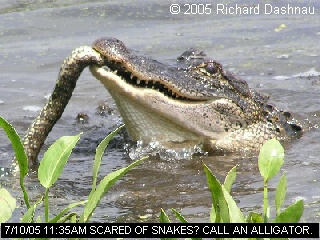 ---------
---------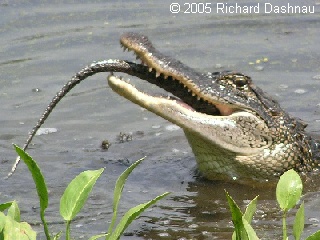 -----------
-----------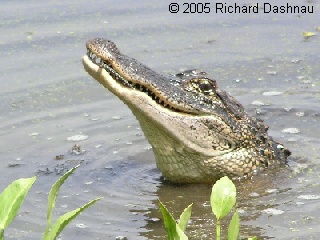
QUIT MOVIN' SO I CAN SWALLOW
YOU
DOWN
IT
GOES!!
THE
TIP OF THE TAIL
I got my camera ready, and
was looking through the viewfinder when the alligator raised its
head.
Yep! It had a snake for sure! I was only able to snap 3 pictures (I
didn't
use "burst" mode)
before the snake vanished down the alligator's throat.
I couldn't tell what species the snake was (it disappeared too
quickly,
and I couldn't see a head) but I know what kind of snake is was.
A dead
one. Note that the alligator had to lift its head, and make short
"lunges"
up with its jaws to help the snake fall down its throat. (See the
three
pictures above, QUIT MOVIN', DOWN IT
GOES, and TIP OF THE TAIL).
People often ask me what alligators
eat. The answer is: Just about anything they can catch and swallow.
Snakes
also fit this general description.
It was good to be back at
the park!
And,
this page shows alligators at the park,
on land, near various landmarks at the park.
Go back to my main alligator
page, Alligators
Go
back to my home page, Welcome
to rickubis.com
Go
to the main
alligator page

 -
- -
- --
--






















